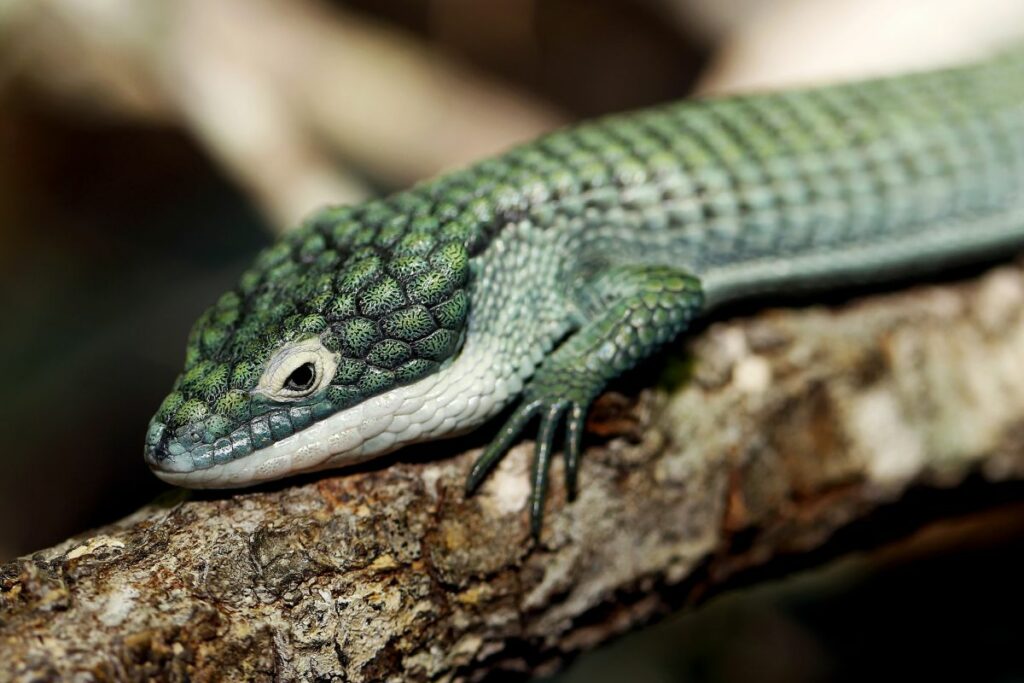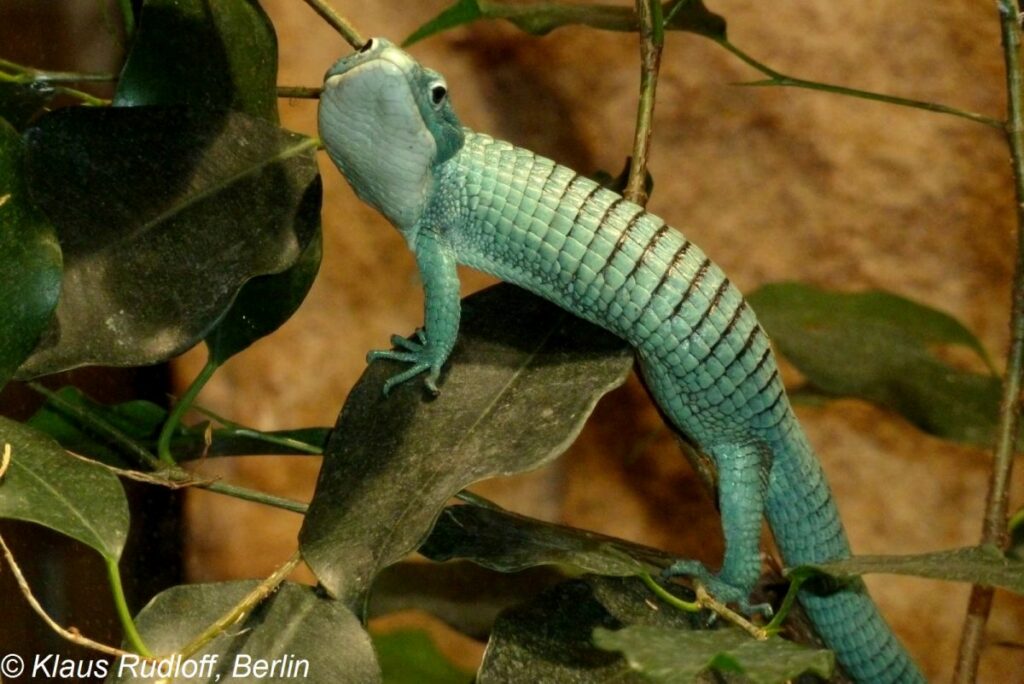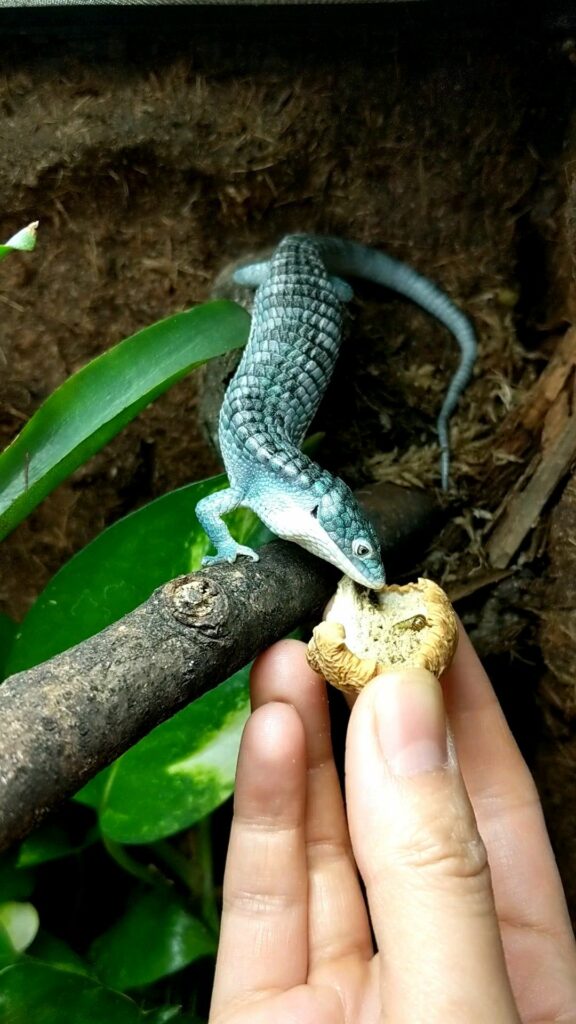One look at a Mexican alligator lizard and the resemblance to alligators and dragons is obvious. Their large, armor-like scales have delicate patterns within. The triangular head and the yellow ring around the eye also draw your attention. But how simple are these prehistoric-looking pets to keep?

What is the Mexican Alligator Lizard?
The Mexican alligator lizard is a highland insectivorous species found in the Sierra Madre de Oaxaca region of the country. At this elevation, the temperatures are moderate and humidity is high.
Their need for humidity and gentle warmth is the main reason why beginners sometimes fail with this species. They use a basking bulb that is too hot or a substrate that does not retain moisture. Both of which will cause dehydration in an alligator lizard.
As beautiful as the natural green variety is, you will also find captive-bred blue alligator lizards for sale. Blue or green, you should always buy captive-bred abronia whenever possible.
Wild-caught adult lizards often have a heavy parasite load. They come to pet stores dehydrated and are also more aggressive.
Captive bred babies cost more but are well worth the price. You are also taking pressure off of wild populations, which are only found in a small region of the world.
Unlike most reptiles, Mexican dragon lizards are viviparous, meaning they don’t lay eggs. A female will give birth to anywhere from 1 to 10 live young. The babies develop inside of her over the course of 6 to 8 months.
- Common Names: Mexican Alligator Lizard, Mexican Dragon Lizard, Arboreal Alligator Lizard, Abronia Lizard
- Scientific Name: Abronia graminea
- Origin: Southern Mexico
- Length: 9 inches
- Enclosure Size: 30 x 20 x 20 inches
- Diet: Insectivorous
- Mexican Alligator Lizard Lifespan: 10 to 15 years
- Ease of Care: Moderate
Mexican Alligator Lizard Care
Mexican alligator lizards are not as easy as leopard geckos and other true beginner species. But they are much more exotic-looking and worth the effort.
Arboreal Alligator Lizard Size

Aligator lizard pets are just small enough to not be a good choice for children. They don’t tolerate rough handling well and are easy to injure. 9 to 12 inches is typical for an adult Mexican alligator lizard, with 40% of that being their tail.
Abronia Enclosure Requirements
Vertical space is important when designing an enclosure for an abronia lizard. They are arboreal animals, meaning that they spend most of their time climbing. Their grasping feet and prehensile tails give them plenty of grip when hunting for insects in the treetops.
Your enclosure should include branches sturdy enough to hold the lizard’s weight. The same goes for any live plants.
Vines that have attached themselves to a hard surface are a good option. As are thick stemmed plants. Alligator lizards are just heavy enough to be able to snap thin stemmed plants.
Air flow is also important for alligator lizard care. This complicates the humidity issue since air flow makes it harder to retain water. While glass tanks hold humidity well they also cause air to stagnate.
You will need a mesh enclosure so that air flows, paired with the right substrate, plants, and a mister. For more guidance, check out this video on how to set up an abronia enclosure:
Humidity for Mexican Alligator Lizards
When designing an enclosure, think in terms of water retention. Their natural habitat is montane cloud forests. Water saturates this environment, from treetops to the ground.
Humidity levels of 70-90% are necessary for good health. While some hobbyists mist often this needs to be done so often that you’re better off with an automated mister.
These are built into the enclosure and will monitor the humidity levels at all times. When they drop below the programmed value, a spray of fine mist fills the air, keeping the lizard moist.
If your mister is going off all of the time, however, your enclosure may need a redesign. Stay away from substrates like sand, which dry too fast. Even bark is not ideal; sphagnum moss, soil, or a mixture of both are the best substrates.
The bottom layer should be both loose and deep since your green alligator lizard will dig into it. If your lizard is spending all of its time covered in soil, that’s a sign that humidity levels are not high enough.
A bowl of water large enough for the lizard to soak in should also be included. Soaking is not just comfortable – alligator lizards use water to soften dead skin. This makes shedding much easier.
Lighting for Abronia Graminea
The arboreal alligator lizard does need a basking and ultraviolet light. But the intensity should be chosen with care. Too much heat is dangerous for these lizards. And you risk drying them out with an intense basking bulb.
Basking temperatures should be no higher than 78-84℉. 74-78℉ is a comfortable ambient temperature for the rest of the setup. At night, you can allow the enclosure to cool further (50-73℉).
Mexican alligator lizards don’t need intense light but they do need a complete spectrum. As with other reptiles, ultraviolet rays in the form of UVb aid calcium uptake. Direct skin exposure to the sun’s rays allows for the creation of vitamin D3.
Without ultraviolet lighting, you will see metabolic bone disease in your alligator lizard pet. Spines may warp, limb and rib bones may fracture. And even when reversed, the deformities are often permanent.
What Does an Alligator Lizard Eat?
As insectivores, the Mexican lizard is simple to feed. You will find plenty of insects of the right size from local pet stores. Feeder crickets, mealworms, dubia roaches, and wax worms are also easy to raise yourself.
A full grown blue mexican alligator lizard needs to eat 3 times per week. Baby lizards should be fed every day since they need the extra protein to fuel their growth. Feed fatty insects like wax worms as a treat rather than an everyday addition.
I also recommend gut-loading any insects you purchase. That means waiting a day and offering the insects nutritious vegetable-based foods.
The insects will pass on these pre-digested meals onto their predator, the alligator lizard. You should also dust any insects with calcium and vitamin D3 powder as well right before feeding your pet lizard.
Do Alligator Lizards Bite?
Abronia graminea tend to have distinct personalities. Some individuals are tame and trustworthy, while others are aggressive biters.
They are not large lizards but they do have powerful jaws and sharp teeth. A Mexican alligator lizard bite will leave a painful bruise and may even break the skin.
Wild caught Mexican alligator lizards are the most aggressive. Even with regular handling they may never become tame. Captive bred specimens are better, especially if you buy a baby that has been handled often.
Tame alligator lizards will move fast if frightened. But they are one of the more docile species of smaller lizards. They walk slow and won’t run up your walls like a gecko. Alligator lizards will treat your arm and hand like a branch, clinging to it with their tail while exploring.
Alligator Lizard Male or Female
A male Mexican alligator lizard is very similar in color and size to a female. The main difference is that males have twin swellings (hemipenal bulges). You will find these near the cloacal opening at the base of the lizard’s tail.
Female alligator lizards sometimes have color shifts of gold or orange along their backs. But the hemipenal bulges are the best indicator of whether you have a male or female lizard.
Conclusion
The Mexican alligator lizard is more challenging for beginners. They have specific temperature, air flow, and humidity needs. But they eat standard insect fare and are handleable if well trained. A well informed hobbyist will have little trouble with these dragon-like reptiles.
More FAQs About Mexican Alligator Lizards
It may take some time to find a Mexican alligator lizard for sale. Reptile specialist stores will either carry them or will order one for you. But they are too pricey and sensitive for chain pet stores. An average alligator lizard price is $200 to $400, depending on the size, color morph, and source (wild-caught vs captive-bred).
As a medium sized reptile, aligator lizards will grow 9 to 12 inches long. Their name comes from their appearance, rather than their size.
Some North American lizards are known to be venomous, including the GIla Monster (Heloderma suspectum). The Mexican alligator lizard has a fierce bite for such a little reptile. But it is not venomous, just painful.

